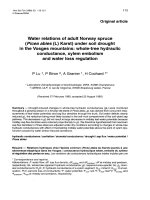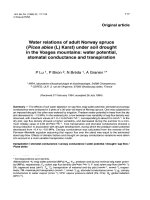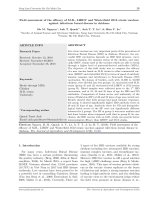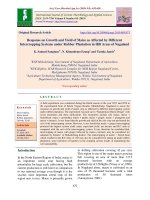Assured income and employment of beneficiary and non-beneficiary through different activities implemented under watershed programme in Nagaland
Bạn đang xem bản rút gọn của tài liệu. Xem và tải ngay bản đầy đủ của tài liệu tại đây (237.88 KB, 11 trang )
Int.J.Curr.Microbiol.App.Sci (2019) 8(9): 2953-2963
International Journal of Current Microbiology and Applied Sciences
ISSN: 2319-7706 Volume 8 Number 09 (2019)
Journal homepage:
Original Research Article
/>
Assured Income and Employment of beneficiary and non-beneficiary
through different activities Implemented under watershed
programme in Nagaland
Mukesh Kumar Yadav and Amod Sharma*
Department of Agricultural Economics, Nagaland University SASRD Medziphema Campus,
District: Dimapur - 797 106, Nagaland, India
*Corresponding author
ABSTRACT
Keywords
Nagaland, income,
employment,
beneficiaries, nonbeneficiaries,
activities.
Article Info
Accepted:
25 August 2019
Available Online:
10 September 2019
The present study to access the assured income and employment through
different activities implemented under watershed programme with reference to
the beneficiaries and non-beneficiaries for the purposely selected two districts
from the Nagaland state viz; Dimapur and Kohima as both were selected
purposely due to the maximum number of area covered under watershed in the
zone and further two blocks from each district were randomly selected, while
in the second stage a multi stage random purposive sampling methods viz; 320
respondents (160 beneficiaries and 160 non-beneficiaries) were selected
randomly from identified watershed areas. Further study reveals that overall
average of beneficiaries income was found to be maximum (22.75 per cent)
through forestry and plantation crop, followed by 21.03 per cent through crop
production, while it was least through service as 3.45 per cent of the total
income. Even overall average the employment trend shows maximum (40.37
per cent), followed by animal husbandry as 21.72 per cent contributed towards
the employment generated on the beneficiary watershed programme during the
study period.
Introduction
Watershed management activities is the
process of guiding and organizing land, soil
and other resource use on a watershed to
provide needed goods and services and
simultaneously conserving soil, water and land
natural resources. The interrelationships
among soil land used and water, and the
linkages between up-stream and downstream
area are given an explicit significance in
watershed approach. Watershed management
focuses on using resources in a productive and
sustainable manner. The primary objective of
watershed management is to slow down or if
possible reversing the manmade degradation
2953
Int.J.Curr.Microbiol.App.Sci (2019) 8(9): 2953-2963
which is mostly manifested in accelerated runoff usually with heavy sedimentations,
reduced
agricultural
productivity
and
progressive removal of vegetative cover on
non-arable land. watershed management
project help in internalizing the externalities
caused by flooding from a large number of
seasonal torrents every year (Sharma et al.,
2015).
Since 1970, there have been heavy
investments
by
Central
and
State
Governments in the watershed development
projects. Integrated Watershed Management
has been identified as a key for planning and
management of natural resources in mountain
ecosystems. It provides an ecologically sound
economic base for the watersheds and its
people. In any developmental activity, the
watershed approach is more scientific because
the inherent potential of soil, water and forest
recourses in a particular area is controlled by
various factors such as physiography,
geological base, soil characteristic, climate,
present land use, socio-economic aspects
(Anon. 2016).
Nagaland is 16,529 sq. km and total
population of 1,980,602 and having a
population density of 120 people per km. The
state is mostly comprised of hilly terrain, with
plain areas limited to only Dimapur. It can be
noted that Kohima, the capital of Nagaland
has an elevation of 1444 km. It has eleven
districts viz; Kohima, Dimpaur, Kiphire,
Longleng,
Zunheboto,
Phek,
Peren,
Mokokchung, Mon, Tuensang and Wokha and
a collection of 16 tribes residing in this hilly
state. Kohima, the capital of Nagaland, is a
hilly district sharing its borders with Dimapur
in the West, Phek District in the East, Peren in
the South and Wokha in the North. It has a
humid subtropical climate, with an elevation
of 1444 metres and covers an area of 1463 sq.
km. Dimapur District is the centre for many
commercial activities. It is bounded by
Kohima district on the South and East, Karbi
Anglong on the West, Golaghat District of
Assam, in the North. A large area of the
District is in the plains with an average
elevation of 260 m above sea level with an
area of 927 sq. km (Anon. 2017).
Materials and Methods
The state of Nagaland characterized by
undulating, highly erodible and degrading
tracts, having more than 85.00 per cent of rain
feed area watershed approach constitute most
suitable approach of development for such hill
areas.
The
approach
is
holistic,
multidisciplinary, and integrated involving
close coordination of different activities
departments. In the past, planning based on
administrative units has failed to take in to
account the peculiar problems, resulting from
the historical process of over-exploitation of
various natural resources, in each locality
(Mishra et al., 2014).
The State of Nagaland was formally
inaugurated on December 1st, 1963, as the
16th State of the Indian Union. From 2011
census, the total geographical area of
For the present study two districts were
selected purposively viz; Dimapur and
Kohima due to the maximum areas and
catchment areas in the first stage, while in the
second stage, a multi stage stratified random
sampling were used for the selection of
beneficiary and non-beneficiary viz; 320
respondents (160 beneficiaries and 160 nonbeneficiaries) were selected randomly from
identified watershed areas. Further study
reveals that two blocks from each district will
be selected randomly for the present study as
these blocks are well covered the watershed
programme successfully. Altogether eight
villages were selected randomly from each
district, while four villages from each block
were selected and listed which would be
obtained from the offices of SDO (Civil), R.
2954
Int.J.Curr.Microbiol.App.Sci (2019) 8(9): 2953-2963
D. block headquarter and other related offices.
However, it is proposed to select four villages
from each block randomly covered the water
shed programme / schemes. After selection of
the villages, a list of beneficiaries and nonbeneficiaries of watershed management will
be prepared from each of the selected village.
In order to have representative sample from
each village a sample of 20 numbers of cases,
out of that 10 from beneficiaries and 10 from
non-beneficiaries will be drawn following the
purposively random sampling method. For the
present study primary data were collected with
the help of pre-tested structured scheduled and
secondary data were collected from different
sources etc. This will result in selection of 320
respondents from 8 villages, out of which 160
will be beneficiaries of the schemes and 160
will be non-beneficiaries of the watershed
schemes for comparisons, so the simple
systematic purposive randomly sampling
techniques with the two specific
objectives to conduct the present study
viz; (i). To examine the total income through
different activities adopted under watershed
programme, and (ii). To study the average
assured employment generated through
different activities adopted under watershed
programme.
Results and Discussion
Table 1 reveals that overall beneficiaries
income was recorded as maximum (22.75 per
cent) from forest and plantation crops,
followed by crop production with 21.03 per
cent, 20.38 per cent through animal
husbandry, 17.36 per cent through other
sources, fishery sector contributes 5.39 per
cent and it was recorded least with 3.45 per
cent through business, respectively. Even the
chi-square value was found to be significant at
5 per cent level of significance on
beneficiaries group for all the sectors of
income viz; crop production, forest and
plantation crop, animal husbandry, fishery,
service, business and other sources of income
etc; whereas Similar studies were find out by
the Sharma (2002); Sharma and Sharma
(2008); Shuya and Sharma (2014); Walling
and Sharma (2015); Walling et al., (2017);
Shuya and Sharma (2018).
Table 2 reveals that the non-beneficiaries the
maximum percentage was recorded (26.55 per
cent) from animal husbandry, followed by
crop production with 20.96 per cent, 10.95 per
cent through forest and plantation crops, 9.13
per cent from other sources, fishery sector
contributes 8.12 per cent and it was recorded
least with 3.22 per cent through business,
respectively. The chi-square value was found
significant at 5 per cent level of significance
for non-beneficiaries it was found significant
on service business and through other source
of income, respectively. Similar studies were
find out by the Sharma (2004); Sharma
(2011); Mishra et al., (2014); Sharma et al.,
(2016); Walling et al., (2017); Sangtam and
Sharma (2015); Pongeneer and Sharma
(2018). Table 3 reveals that overall
beneficiaries employment was recorded as
maximum (40.37 per cent) from crop
production, followed by 21.72 per cent
through animal husbandry, other sources
contributes 20.80 per cent, 11.20 per cent
through forest and plantation crops, fishery
sector contributes 5.89 per cent and it was
recorded as least, respectively. Even the chisquare value was found to be significant at 5
per cent level of significance on beneficiaries
group for all the sectors of income viz; crop
production, forest and plantation crop, animal
husbandry, fishery and other sources of
income etc; whereas Similar studies were find
out by the Sharma (2002); Sharma (2004);
Sharma (2011); Sharma (2012); Mishra et al.,
(2014); Sharma (2014); Sangtam and Sharma
(2015); Walling et al., (2017); Pongeneer and
Sharma (2018) Sharma et al., (2018); Shuya
and Sharma (2018).
2955
Int.J.Curr.Microbiol.App.Sci (2019) 8(9): 2953-2963
Table.1 Income per annum of different family respondents of beneficiaries
S.No
Groups
1.
Small
2.
Medium
3.
Large
4.
Average
Chi-square
value
Crop
Animal
production Husbandry
Fishery
Forest &
Plantation
Service
Business
Others
Total
41270.83
25700.74
24798.47
10789.5
46333.33
7275.35
18812.5
168314.81
20.29
14.99
6.55
21.55
22.77
5.04
8.80
100.00
42394.56
47327.3
19328.12
12265.7
46880.7
9157.89
22947.4
201287.05
21.44
17.29
6.48
23.78
18.48
2.99
9.52
100.00
52943.3
54993.8
17178.89
27954.1
43088.23
10250
21437.5
234263.23
20.69
17.87
3.89
21.77
21.94
3.70
10.55
100.00
47802.9
56938.36
20435.16
23481.24
45434.09
8894.41
21065.8
201288.36
21.03
17.36
5.39
22.75
20.28
3.45
9.89
100.00
202.978
93.708
6.453
98.672
35.796
12.968
17.889
-
p = 0.695*
p = 0.220*
p = 0.597*
p = 0.351*
p = 0.057*
p = 0.371*
p = 0.996*
(The figure in the parentheses indicates percentage in total; Asterisk showed non-significant. Data showed significant at p< 0.05)
2956
Int.J.Curr.Microbiol.App.Sci (2019) 8(9): 2953-2963
Table.2 Income per annum of different family respondents of non- beneficiaries
S.No
Groups
1.
Small
2.
Medium
3.
Large
4.
Average
Crop
Animal
production Husbandry
Fishery
Forest &
Plantation
Service
Business
Others
Total
20345.26
33825
0.0
1333.34
36550
4387.5
17916.7
121231.47
(14.38)
(18.15)
(0.00)
(7.62)
(31.30)
(6.47)
(16.21)
(100.00)
34860.16
36538.75
13500
14737.5
43088.2
9157.89
15720.6
159697.52
(18.84)
(25.58)
(10.98)
(6.63)
(24.02)
(2.37)
(11.59)
(100.00)
47578.5
31095.59
919.12
16623.52
44437.5
7155.96
18440.37
183006.03
(22.82)
(23.71)
(10.17)
(12.05)
(20.21)
(3.09)
(7.95)
(100.00)
34261.31
34021.87
7140.62
14533.74
41358.57
6900.45
17359.22
154645.02
(20.96)
(26.55)
(8.12)
(10.95)
(21.08)
(3.22)
(9.13)
(100.00)
245.734
200.765
55.468
60.196
26.382
10.713
40.126
Chi-square
p = 0.000
p = 0.000
p = 0.000
p = 0.000 p = 0.334* p = 0.554* p = 0.102*
value
(The figure in the parentheses indicates percentage in total; Asterisk showed non-significant. Data showed significant at p< 0.05)
2957
Int.J.Curr.Microbiol.App.Sci (2019) 8(9): 2953-2963
Table.3 Employment of different family respondents of beneficiaries in man days
S.No
Groups
1.
Small
Crop production
Animal Husbandry
M
F
T
M
F
96.42
71.05
167.47
48.42
73.68
(22.17)
(16.34)
(38.51)
(11.13)
(16.94)
T
Fishery
Plantation
Others
Total
M
F
T
M
F
T
M
F
T
M
F
T
122.1
9.47
9.47
18.95
35.79
17.89
53.68
39.47
33.16
72.63
229.58
205.26
434.84
(28.07)
(2.18)
(2.18)
(4.36)
(4.11)
(12.34)
(9.08)
(7.63)
(16.70)
(52.79)
(47.20)
(100.00)
(8.23)
2.
Medium
3.
Large
4.
Average
Chi-square
value
125.16
70.31
195.47
47.5
60.93
108.44
18.75
12.19
30.93
41.25
19.37
60.62
63.75
50.62
114.37
296.41
213.44
509.5
(24.56)
(13.79)
(38.36)
(9.32)
(11.96)
(21.28)
(3.68)
(2.39)
(6.07)
(8.09)
(3.80)
(11.89)
(12.51)
(9.93)
(22.44)
(58.17)
(41.89)
(100.00)
143.67
63.99
207.66
52.48
52.75
105.23
16.24
14.31
30.55
37.43
17.06
54.5
57.52
47.89
105.41
307.34
196.0
503.35
(28.54)
(12.71)
(41.25)
(10.42)
(10.47)
(20.90)
(3.22)
(2.84)
(6.06)
(7.44)
(3.39)
(10.82)
(11.43)
(9.51)
(20.94)
(61.05)
(38.94)
(100.00)
134.35
66.09
200.45
51
56.87
107.87
15.93
13.31
29.25
38
17.62
55.62
56.62
46.69
103.31
295.92
200.59
496.51
(27.06)
(13.31)
(40.37)
(10.27)
(11.45)
(21.72)
(3.20)
(2.68)
(5.89)
(7.65)
(3.54)
(11.20)
(11.40)
(9.40)
(20.80)
(59.60)
(40.39)
(100.00)
48.399
36.377
6.992
14.919
20.927
168.289
p = 0.170*
p = 0.085*
p = 0.726*
p = 0.246*
p = 0.051*
p =0.311*
(The figure in the parentheses indicates percentage in total; Asterisk showed non-significant. Data showed significant at p< 0.05)
2958
Int.J.Curr.Microbiol.App.Sci (2019) 8(9): 2953-2963
Table.4 Employment of different family respondents of non-beneficiaries in man days
S.No
Groups
1.
Small
2.
Mediu
m
3.
Large
4.
Average
Crop production
Animal Husbandry
M
F
T
M
135
46.25
181.25
(39.85)
(13.65)
124
Fishery
Plantation
Others
Total
F
T
M
F
T
M
F
T
M
F
T
M
F
T
36.67
37.5
74.17
17.5
10
27.5
11.67
10
21.67
19.17
15
34.17
220
118.75
338.75
(53.5)
(10.82)
(11.07)
(21.89)
(5.17)
(2.95)
(8.12)
(3.44)
(2.95)
(6.39)
(5.66)
(4.43)
(10.09)
(64.94)
(35.05)
(100)
54.44
178.44
46.62
55.5
102.12
9.88
10.12
20
19.25
13.25
32.5
35.62
30.12
65.75
235.38
163.44
398.81
(31.09)
(13.65)
(44.74)
(11.69)
(13.92)
(25.6)
(2.48)
(2.54)
(5.02)
(4.83)
(3.32)
(8.15)
(8.93)
(7.55)
(16.49)
(59.02)
(40.98)
(100)
131.17
65.59
196.76
38.97
49.71
88.68
12.06
11.47
23.53
24.7
9.7
34.41
41.03
40.73
81.76
247.94
177.2
425.15
(30.85)
(15.41)
(46.28)
(9.17)
(11.69)
(20.86)
(2.84)
(2.69)
(5.53)
(5.81)
(2.28)
(8.09)
(9.65)
(9.58)
(19.23)
(58.32)
(41.68)
(100)
127.87
58.56
186.44
42.62
51.69
94.31
11.37
10.68
22.06
21
11.5
32.5
36.69
33.5
70.19
239.56
165.94
405.5
(31.53)
(14.44)
(45.98)
(10.51)
(12.75)
(23.26)
(2.8)
(2.63)
(5.44)
(5.18)
(2.84)
(8.01)
(9.05)
(8.26)
(17.31)
(59.08)
(40.92)
(100)
61.838
25.278
29.374
23.094
20.927
42.243
Chi-square
p = 0.276*
p = 0.711*
p = 0.044
p = 0.059*
p = 0.051*
p =0.006
value
(The figure in the parentheses indicates percentage in total; Asterisk showed non-significant. Data showed significant at p< 0.05)
2959
Int.J.Curr.Microbiol.App.Sci (2019) 8(9): 2953-2963
Fig.1 Distribution of respondent family groups according to average income from different sources per annum
2960
Int.J.Curr.Microbiol.App.Sci (2019) 8(9): 2953-2963
Fig.2 Distribution of respondent family groups according to average Man days generated
2961
Int.J.Curr.Microbiol.App.Sci (2019) 8(9): 2953-2963
Table 4 reveals that the non-beneficiaries
employment was found to be maximum
percentage as (45.98 per cent) from cropping
pattern (crop production) with 23.26 per cent,
17.31 per cent through other sources of
income, forest and plantation crops contributes
8.02 per cent, the fishery sector contributes
5.44 per cent recorded as least source of
income, respectively. The chi-square value
was found significant at 5 per cent level of
significance for non-beneficiaries it was found
significant on service business and through
other source of income, respectively. Similar
studies were find out by the Sharma (2002);
Mishra et al., (2014); Sharma et al., (2015);
Walling et al., (2017); Shuya and Sharma
(2018).
References
Analogous. 2016. Agricultural Situation in
India. Directorate of Economics and
Statistics. Ministry of Agriculture, New
Delhi.
Analogous. 2017. Statistical Hand of
Nagaland Published by Directorate of
Economics and Statistics (various
issues), Kohima, Nagaland.
Mishra, A.; Pattnaik, B. R. and Ray, Plabita.
2014.
Impact
of
Watershed
Development Programme on Socioeconomic Development of the People.
Journal of Extension Education. 39(1):
182-189.
Pongener, Bendangjungla. and Sharma,
Amod. 2018. Constraints Faced by the
Fishery Enterprises: A SWOC Analysis.
IJCMAS. 7(5). May: 1595-1603.
Sangtam, Likhase. L. T. and Sharma, Amod.
2015. Impact of Bank Finance on
Employment and Income through
Piggery Enterprise in Nagaland.
EPRAIJEBR. 3(11). Nov: 273-276.
Sharma, A. 2002. Source and Knowledge on
beneficiaries about the purpose of credit
- A case study of Agra Region of Uttar
Pradesh. Journal of Interacademica.
6(3). July: 374-379.
Sharma, A. 2004. Constraints of Fish
Production - A case study in rainfed
areas of Uttar Pradesh. Journal of
Interacademica. 8(4). October: 639-643.
Sharma, A. and Sharma, Anamika. 2008.
Problems faced by the farmers in
adoption of improved maize cultivation
practices in hills. TJRAR. 8(2): 22-23.
Sharma, Amod. 2011. Economic and
Constraints of King Chilli Growers in
Dimapur District of Nagaland. Journal
of Interacademicia. 15(4): 710-719.
Sharma, Amod. 2012. Inter-state Disparities in
Socio-economic Development in North
East Region of India. Journal of
Agricultural Science. 4(9). September:
236-243.
Sharma, Amod. 2014. Sustainable economic
analysis and extent of satisfaction level
of King Chilli growers in Nagaland.
Agriculture
for
Sustainable
Development. 2(1). June: 188-191.
Sharma, Amod.; Kichu, Yimkumba. and
Chaturvedi, B. K. 2016. Economics and
Constraints of Pineapple Cultivation in
Dimapur District of Nagaland. TJRAR.
16(1). January: 72-75.
Sharma, Amod.; Kichu, Yimkumba. and
Sharma, Pradeep. Kumar. 2018.
Sustainable economic analysis and
constraints faced by the pineapple
growers in Nagaland. Progressive
Agriculture. 18(1). February: 27-33.
Sharma, Rajan., Chauhan, Jitendra., Meena, B.
S. and Chauhan, R. S. 2015. Problems
Experienced By Farmers and Project
Officers in Watershed Management.
Indian Research Journal of Extension
Education. 15(2&3): 23-27.
Shuya, Keviu. and Sharma, Amod. 2014.
Impact and constraints faced by the
borrowers of cooperative bank finance in
Nagaland. Economic Affairs. 59(4).
October: 561-567.
2962
Int.J.Curr.Microbiol.App.Sci (2019) 8(9): 2953-2963
Shuya, Keviu. and Sharma, Amod. 2018.
Problems faced by the Borrowers in
Utilization and Acquiring of Cooperative
Bank Loans in Nagaland. IJED. 14(2).
April-June: 52-56.
Walling, Imti. and Sharma, Amod. 2015.
Impact of SGRY on beneficiaries and
non-beneficiaries in Dimapur district of
Nagaland. TJRAR. 15(2). August: 90-94.
Walling, Imti.; Sharma, Amod.; Yadav,
Mukesh. Kumar.; Rajbhar, Arun,
Kumar. and Kalai, Kankabati. 2017.
Impact of Agricultural Technology
Management Agency on Rural Economy
of Nagaland, India. Plant Archiver.
17(2). October: 1511-1516.
How to cite this article:
Mukesh Kumar Yadav and Amod Sharma. 2019. Assured Income and Employment of
beneficiary and non-beneficiary through different activities Implemented under watershed
programme in Nagaland. Int.J.Curr.Microbiol.App.Sci. 8(09): 2953-2963.
doi: />
2963









